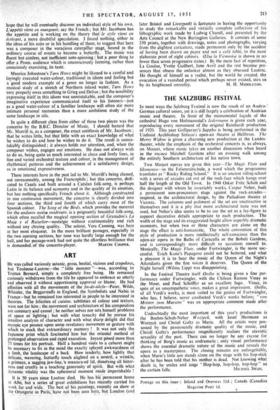ART
HE was called variously satanic, gross, bestial, vicious and crapulous, but. Toulouse-Lautrec—the ." little monster "—was, according to Tristan Bernard, simply a completely free being. He remained curiously withdrawn from the life he appeared to embrace so utterly and observed it without apportioning approval or blame. He had affinities with all the movements of the fin-de-siecle—Pater, Wilde, Whistler, the Beggarstaffs in England, the Symbolists and Nabis in France—but he remained too interested in people to be interested in theories. The felicities of cuisine, subtleties of colour and texture, were not for him ; the movement and architecture -a his composition are summary and casual ; he neither solves nor sets himself problems of space or lighting ; but with what tenacity did he pursue his intuitive analysis of character and with what sharp delight did that myopic eye pounce upon some revelatory movement or gesture with which to stock that extraordinary memory ! It was not only the Japanese print which fascinated him but the oriental method of prolonged observation and rapid execution. Joyant posed more than 75 times for his portrait. Half a hundred visits to a cabaret might be necessary to fix in the mind the exactly splayed awkwardness of a limb, the landscape of a back How tenderly, how lightly that delicate, wavering, butterfly touch alighted on a nostril, a wrinkle, a grimace, a sagging jaw-line,"a mascara-ed lid, dissolving all bitter- ness and cruelty in a touching generosity of spirit. But with what dynamic vitality was the ephemeral moment made imperishable !
It is 50 years since Lautrec died. He has his permanent home at Albi, but a series Of great exhibitions has recently carried his work far and wide. The best of his paintings, recently on show at the.Orangerie in Paris; have not been seen here, but London (and later Bristol and Liverpool) is fortunate in having the opportunity to study the remarkable and virtually complete collection of his lithographic work made by Ludwig Charell, and presented by the Arts Council at the New Burlington Galleries. It consists of some 330 prints, together with drawings, notes and photographs, varying from the slightest caricature, made permanent only by the accident of having been drawn on paper and not a café table, to the most elaborate print of eight colours. (Elsa la Viennoise is shown in no fewer than seven progressive states.) By the mere fact of repetition, La Goulue, Yvette Guilbert, Jane Avril and the rest become pre- sences that obsess the onlooker almost as they obsessed Lautrec. He thought of himself as a realist, but the world he created, the evocation of a vanished period which perhaps never existed, stirs us






























 Previous page
Previous page